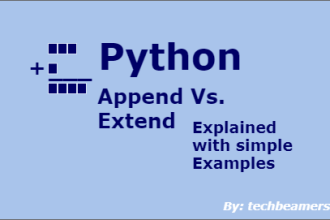In Python, working with lists is a common task, and accessing the last element of a list is a frequent requirement. In this tutorial, we will explore various Python methods to efficiently get the last element in a list. We’ll discuss different techniques, their pros and cons, and provide code examples to illustrate each method. By the end of this tutorial, you’ll have a comprehensive understanding of these methods and be able to choose the most suitable one for your specific use case.
Python Methods to Get the Last Element in a List
Lists are one of the most important data structures in Python. They are used to store collections of data in an ordered and indexed way. To get the last element of a list, there are a few different methods that you can use.
1. Using Indexing to Get the Last Element of a List
One of the most straightforward methods to get the last element of a list is by using negative indexing. In Python, you can access elements from the end of a list by using negative indices, where -1 refers to the last element, -2 to the second-to-last, and so on. Here’s how you can do it:
my_list = [1, 2, 3, 4, 5]
last_element_indexing = my_list[-1]
print(last_element_indexing) # Output: 5This method is concise and easy to understand. However, it’s essential to ensure that the list is not empty before using negative indexing, as it will raise an “IndexError” if the list is empty.
2. Using Pop() to Get the Last Element in a List
The pop() method not only removes the last element from a list but also returns it. This makes it a useful option to get the last element while modifying the list simultaneously. Here’s how it works:
my_list = [1, 2, 3, 4, 5]
last_element_pop = my_list.pop()
print(last_element_pop) # Output: 5
print(my_list) # Output: [1, 2, 3, 4]Keep in mind that using pop() will change the original list, so make sure this behavior aligns with your intended usage.
3. Use Slicing to Get the Last Element of a List
Slicing is a versatile technique in Python that we can use to get the last element in a list. To get the last element, you can slice the list with a negative index like this:
my_list = [1, 2, 3, 4, 5]
last_element_slicing = my_list[-1:]
print(last_element_slicing) # Output: [5]This method returns the last element as a list containing a single item. If you want to get it as a single value, you can access it using indexing: last_element_slicing[0].
4. Using the [-1] Shortcut
Another convenient way to get the last element in a list is by using the [-1] index in Python. This is similar to negative indexing but in a cleaner way:
my_list = [1, 2, 3, 4, 5]
last_element_shortcut = my_list[-1]
print(last_element_shortcut) # Output: 5This method is concise and clear but has the same limitation as negative indexing; it will raise an “IndexError” if the list is empty.
5. Using List Comprehension
List comprehension is a concise and elegant way to retrieve the last element of a list. Here’s how you can do it:
my_list = [1, 2, 3, 4, 5]
last_element_comprehension = my_list[-1] if my_list else None
print(last_element_comprehension) # Output: 5List comprehension allows you to provide a default value (in this case, None), when the list is empty, avoid the “IndexError” that negative indexing and the shortcut [-1] may encounter.
6. Using collections.deque
Python’s collections module comes with a deque class which provides an efficient way to get the last element of a list. It’s particularly useful when dealing with large lists and requires constant time complexity for accessing both ends of the list:
from collections import deque
my_list_deque = [1, 2, 3, 4, 5]
deque_list = deque(my_list_deque)
last_element_deque = deque_list[-1]
print(last_element_deque) # Output: 5This method is efficient for large lists and has constant time complexity, making it suitable for performance-critical applications.
Comparison of Methods (Table)
| Method | Pros | Cons | Suitable Use Cases |
|---|---|---|---|
| Negative Indexing | Simple and the most efficient | Raises IndexError if the list is empty | When you want a quick and straightforward solution |
pop() Method | Retrieves and modifies the list in one go | Alters the original list | When you need to remove the last element |
Slicing with [-1:] | Provides flexibility for slicing | Returns the last element as a list | When you need a slice of the last element |
[-1] Shortcut | Concise and clear | Raises IndexError if list is empty | When you want a simple and readable approach |
| List Comprehension | Concise and handles empty lists gracefully | Requires a default value for empty lists | When you want a concise and elegant solution |
collections.deque | Efficient for large lists | Requires importing the deque module | When dealing with large lists or performance optimization |
It’s possible that there are more innovative and faster methods to get the last element of a list, but the methods we covered are the most common and efficient methods.
Here are some additional thoughts on how to make the process of getting the last element of a list more innovative and faster:
- Use a custom-built data structure. A custom-built data structure, such as a circular list, could be designed specifically for getting the last element of a list quickly.
- Use a parallel algorithm. A parallel algorithm could be used to search for the last element of a list across multiple cores or processors.
- Use machine learning. A machine learning model could be trained to predict the last element of a list based on the first few elements of the list.
Conclusion
In Python, there are several methods to retrieve the last element of a list, each with its advantages and disadvantages. The choice of method depends on your specific use case and requirements. If simplicity and readability are crucial, using negative indexing, [-1] shortcut, or list comprehension is recommended.
If you need to modify the list while retrieving the last element, the pop() method is a suitable choice. For larger lists or performance-critical scenarios, consider using collections.deque class for the purpose of efficiency. Understanding these methods will empower you to work with lists effectively in Python.





